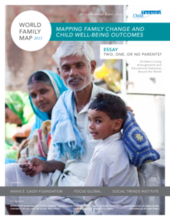The World Family Map Project is a new initiative by Child Trends to monitor the health of family life around the globe and to learn more about how family trends affect the well-being of children. Recognizing the centrality of the family to child and adult well-being and the changing dynamic and structure of families today, the project will issue an annual report, The World Family Map, using internationally comparative data for low-, middle-, and high-income countries to map trends in family structure, family socioeconomics, family processes, and family culture in every region of the world. For its inaugural 2013 edition, the map covers family trends in 45 countries, representing every region of the world, as well as a majority of the world’s population. This edition also features an essay, Two, One or No Parents? Children’s Living Arrangements and Educational Outcomes Around the World, which explores the links between one indicator of family structure and children’s educational outcomes in low-, middle-, and high-income countries.
The map shows that family trends and strengths vary markedly by region but also that there is tremendous variation within regions. These family trends are related to distinct patterns of economic wealth, family solidarity, education, religiosity, and urbanization.
Among key findings, the report confirms that, although two-parent families are becoming less common, they still constitute a majority of families around the globe. Children were most likely to live in two-parent families (who could be biological parents or step parents) in Asia and the Middle East, and somewhat less likely to live in two-parent families in the Americas, Europe, Oceania, and Sub-Saharan Africa.
In much of South America and Sub-Saharan Africa, from 16 percent (Bolivia) to 43 percent (South Africa) of children lived in single-parent families and from four percent (Argentina) to 20 percent (South Africa) of children lived in homes without either of their parents. Among the South American countries in this study, Colombia had the highest percentage of children living without either of their parents: 12 percent. The high percentage of South African children living with one parent or without either parent—43 percent and 20 percent, respectively reflects the high incidence of AIDS orphans, as well as adult mortality from other causes and labor migration. Finally, although a small percentage of children in North America, Oceania, and Europe lived in households without at least one of their parents, a large minority—about one-fifth—lived in single-parent households. Rates were slightly lower in Europe. In these regions, the United States (27 percent), the United Kingdom (24 percent), and New Zealand (24 percent) had particularly high levels of single parenthood.
Also of note, extended families appeared to be common in Asia, the Middle East, South America, and Sub- Saharan Africa, with at least half of children lived with adults besides their parents in parts of Africa (Kenya [52 percent], Nigeria [59 percent], and South Africa [70 percent]); Asia (India [50 percent]); and South America (Nicaragua [55 percent], Peru [51 percent], and Colombia [61 percent]).
The essay presents strong evidence that throughout the world, children who do not live with either parent often exhibit the worst educational outcomes: they are particularly disadvantaged in terms of educational enrollment and performance relative to children in two-parent families, and also experience a disadvantage when compared with children in single-parent families. Children living in two-parent families in middle- and high-income countries on the other hand were more likely to stay on track in school and demonstrate higher reading literacy than children living with one or no parents. However, the study also indicated that the positive effects of living with two parents were much less consistent in low-income countries, with few differences between children living with one versus two parents in many low- income countries once all family and individual background factors were considered, and that there was even an advantage to living with a single parent for some educational outcomes in some countries.
The essay concludes by noting the anomaly of the increasing fragility of two-parent families in most middle- and high-income countries even as the evidence shows that such households give children a hand up in excelling educationally. Ironically, low-income countries may provide insight about how to strengthen families in a climate of instability insofar as those countries rely on extended kin to buffer children from the effects of single parenthood and orphanhood. Overall, the report demonstrates the importance of monitoring the strength of family globally and the benefits of understanding the variety of ways in which families contribute to the well-being of children and youth.
©Annie E. Casey Foundation, Focus Global, and Social Trends Institute (sponsors)

